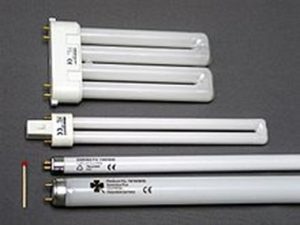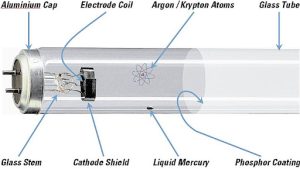In 1926, Jacques Risler, a French engineer, developed a coating for the inside of a fluorescent light that absorbed the light produced by the mercury and produced a visible light with a soothing hue.
The fluorescence of certain rocks and other substances had been observed for hundreds of years before its nature was understood. One of the first to explain it was Irish scientist, Sir George Stokes from the University of Cambridge in 1852, who named the phenomenon “fluorescence” after fluorite, a mineral many of whose samples glow strongly because of impurities.
A fluorescent lamp, or fluorescent tube, is a low-pressure mercury-vapour gas-discharge lamp that uses fluorescence to produce visible light. An electric current in the gas excites mercury vapour, to produce ultraviolet and make a phosphor coating in the lamp glow. Fluorescent lamps convert electrical energy into useful light much more efficiently than incandescent lamps, but are less efficient than most LED lamps. The typical luminous efficacy of fluorescent lamps is 50–100 lumens per watt, several times the efficacy of incandescent bulbs with comparable light output (e.g. the luminous efficacy of an incandescent lamp may only be 16 lm/w).
Fluorescent lamp fixtures are more costly than incandescent lamps because, among other things, they require a ballast to regulate current through the lamp, but the initial cost is offset by a much lower running cost. Compact fluorescent lamps made in the same sizes as incandescent lamp bulbs are used as an energy-saving alternative to incandescent lamps in homes. Florescent Lights these days are being fazed out due to the hazards they pose when broken and the difficulty of recycling them.






